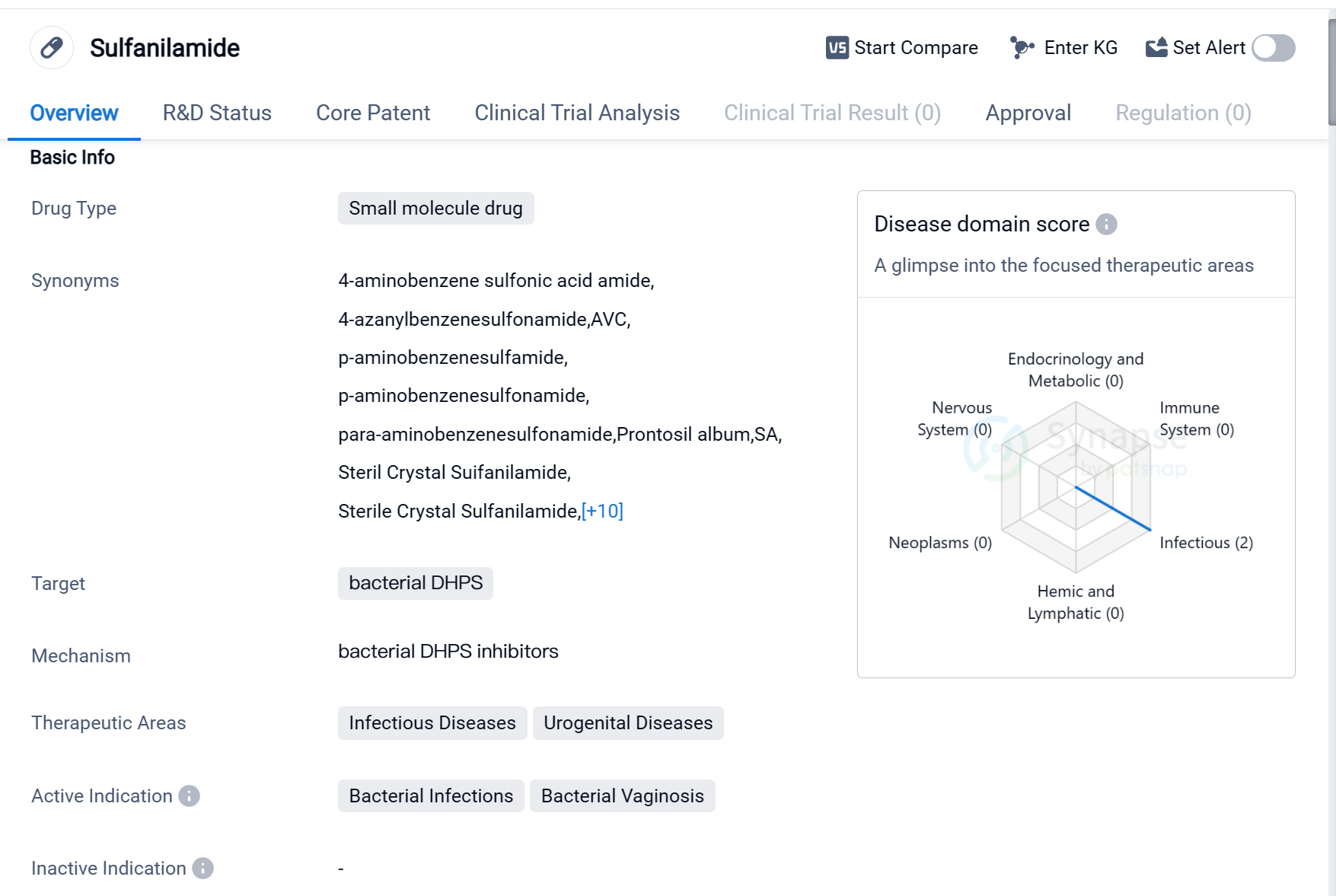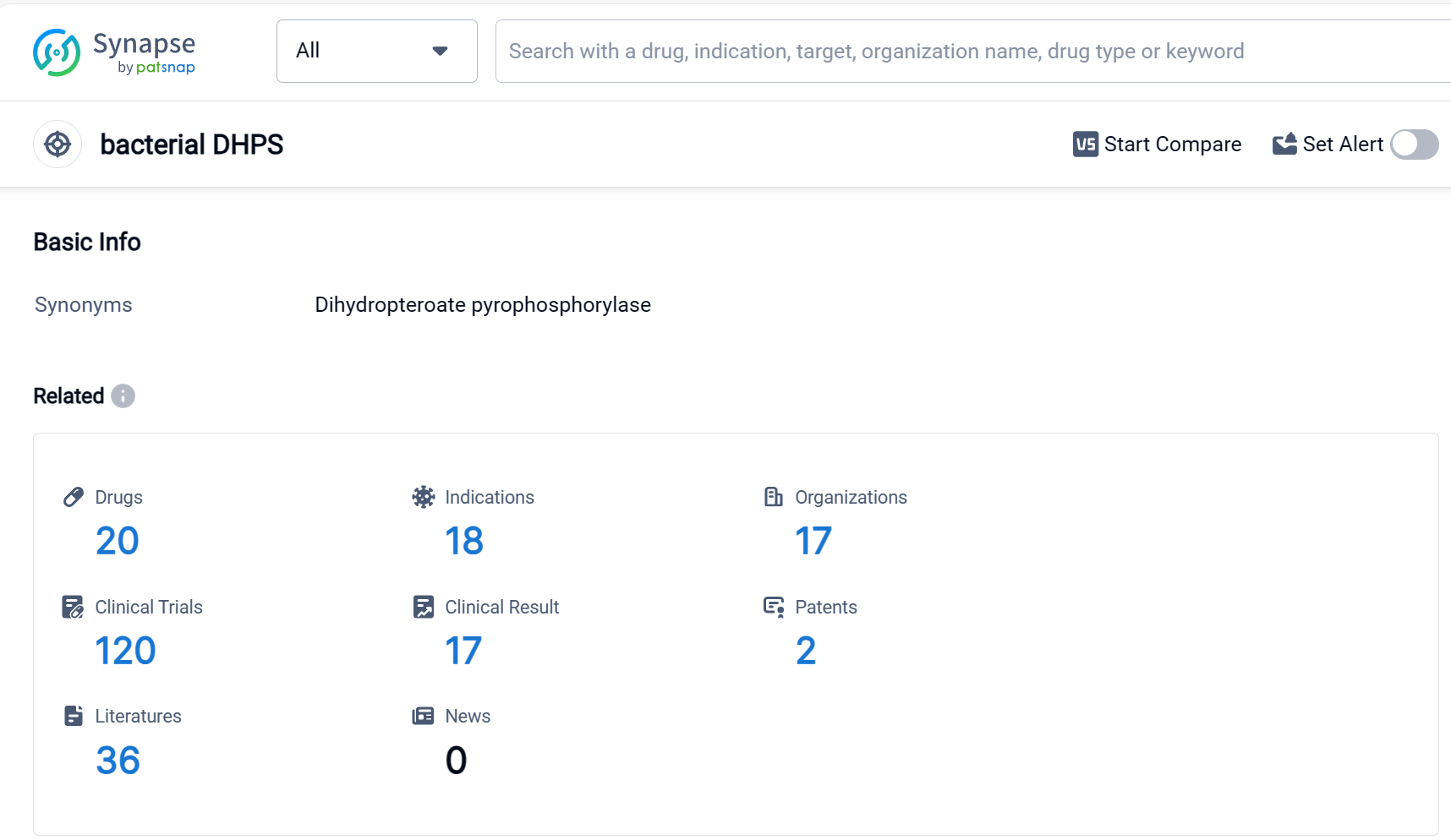Sulfanilamide: Detailed Review of its Transformative R&D Success
Sulfanilamide's R&D Progress
Sulfanilamide is a small molecule drug that is primarily used to target bacterial dihydropteroate synthase (DHPS). It falls under the therapeutic areas of infectious diseases and urogenital diseases, specifically for the treatment of bacterial infections and bacterial vaginosis.
The drug has received approval for use globally. The highest R&D phase of this drug is approved. The first approval for Sulfanilamide was granted in June 1965 in the United States.
Sulfanilamide belongs to a class of drugs known as sulfonamides, which are synthetic antimicrobial agents. These drugs work by inhibiting the growth and reproduction of bacteria by interfering with the synthesis of folic acid, an essential nutrient for bacterial survival. By targeting bacterial DHPS, Sulfanilamide disrupts the production of folic acid, leading to the inhibition of bacterial growth and the subsequent treatment of infections caused by susceptible bacteria.
The therapeutic areas of infectious diseases and urogenital diseases encompass a wide range of conditions caused by bacterial infections. Infectious diseases refer to illnesses caused by pathogenic microorganisms, such as bacteria, viruses, fungi, or parasites. Urogenital diseases, on the other hand, specifically affect the urinary and reproductive systems.
Bacterial infections can occur in various parts of the body, including the respiratory tract, skin, urinary tract, and gastrointestinal tract. Bacterial vaginosis, on the other hand, is a common vaginal infection caused by an imbalance in the vaginal microbiota, leading to an overgrowth of harmful bacteria.
Its long history of use since its first approval in 1965 demonstrates its established position in the pharmaceutical industry.
👇Please click on the image below to directly access the latest data (R&D Status | Core Patent | Clinical Trial | Approval status in Global countries) of this drug.
Mechanism of Action for Sulfanilamide: Bacterial DHPS inhibitor
Bacterial DHPS inhibitors are a type of drugs that target the enzyme dihydropteroate synthase (DHPS) in bacteria. DHPS is an essential enzyme involved in the synthesis of folate, which is necessary for bacterial growth and survival. By inhibiting DHPS, these drugs can effectively disrupt the production of folate in bacteria, leading to their inability to replicate and causing their eventual death. Bacterial DHPS inhibitors are commonly used as antibiotics to treat bacterial infections. They specifically target bacterial DHPS and have minimal impact on human DHPS, making them effective in selectively killing bacteria while minimizing harm to human cells. These inhibitors play a crucial role in combating bacterial infections and are an important class of drugs in biomedicine.
Drug Target R&D Trends for Sulfanilamide
According to Patsnap Synapse, as of 9 Sep 2023, there are a total of 20 bacterial DHPS drugs worldwide, from 17 organizations, covering 18 indications, and conducting 120 clinical trials.
Based on the analysis of the provided data, Pfizer Inc. is the company with the highest number of drugs in the approved phase targeting bacterial DHPS. The most common indication for these drugs is bacterial infections. Small molecule drugs are progressing rapidly in the development of treatments for bacterial DHPS. China is leading in the development of drugs targeting bacterial DHPS, followed by the United States. The competitive landscape for target bacterial DHPS is diverse, with multiple companies and countries/locations involved in the development of drugs. The future development of target bacterial DHPS is promising, especially in the areas of bacterial infections and small molecule drug development.
👇Please click on the picture link below for free registration or log in directly if you have a freemium account, you can browse the latest research progress on drugs, indications, organizations, clinical trials, clinical results, and drug patents related to this target
Conclusion
In summary, Sulfanilamide is a small molecule drug that targets bacterial DHPS and is approved for the treatment of bacterial infections and bacterial vaginosis. Its global approval showcases its effectiveness in combating infectious diseases and urogenital diseases caused by susceptible bacteria.






